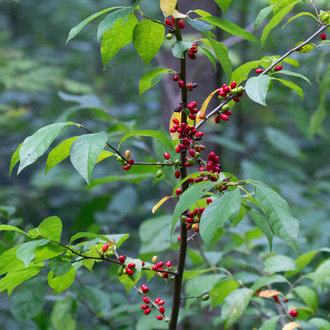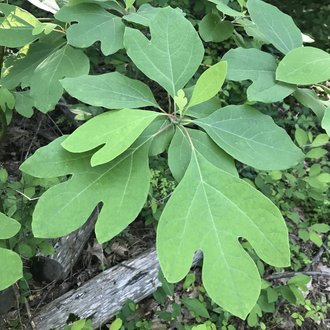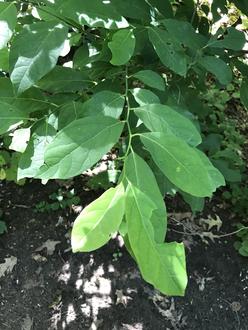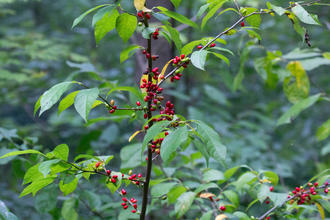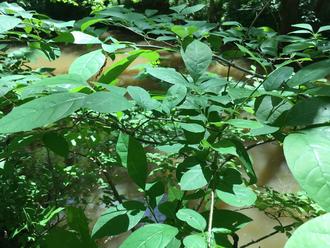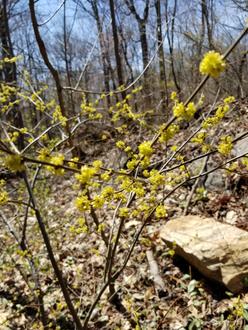Northern Spicebush (Lindera benzoin (L.) Blume)
↑Summary
A native understory shrub of rich deciduous forests in eastern North America.
↑Range - Expand
| Legend | Color |
| Native | |
| Native or Not Present |
This tentative map is based on our own research. It may have limited data on Canada and/or Mexico, and there is some subjectivity in our assignment of plants as introduced vs. expanded. Read more in this blog post.
Although this plant occurs somewhere in each of these regions, it may only occur in a small part of some or all of them.
↑Similar Plants
↑Habitat
Northern spicebush is found in the understory of rich deciduous woods, in moist to mesic conditions. Often common on well-drained sites in bottomlands and floodplain forests, swamp margins, to lower levels of slopes. Often found in woods with tuliptree (Liriodendron tulipifera).
Tolerates slightly drier conditions in denser shade, but limited to moister sites in sunnier conditions. Tolerates a wide range of soil pH from acidic to slightly alkaline. Can tolerate sandy soil if moisture supply is consistent, and tolerates organic muck soils.
↑Life Cycle
Growth rate is variable based on lighting conditions, with fastest growth in gaps, although it can reach maturity under a completely closed canopy.
Flowers in early spring, before leafing out; fruits mature in fall, and are distributed by animals, mainly birds. Some seeds germinate in the spring, but many remain in the seed bank, sprouting subsequent years. Germination and survival is good in rich leaf litter.
In addition to by seed, this species can reproduce vegetatively through root sprouts. This species can form colonies or thickets on favorable sites, and resprouting can also allow this species to take advantage of disturbances that top-kill the plant along with competing vegetation.
We have not yet found a source verifying the exact lifespan of this species, but it is longer-lived for a shrub, especially considering its ability to resprout.
↑Faunal Associations
Numerous native birds eat the berries. The larvae of the Spicebush Swallowtail (Papilio troilus), as well as other Lepidopterae, eat the leaves of this species.
↑Uses
Occasionally used as a landscaping plant, where it is valued for its early flowers, red berries, and the pleasant and distinctive smell of its foliage. Relatively easy to grow, but its use is limited by the fact that it is difficult to transplant.
Historically, this was used as an indicator species for land well-suited to agriculture.
The leaves and fruit are uncommonly used to brew an herbal tea, or as a spice.
↑Related Plants
Two other species, southern spicebush (Lindera melissifolia), and bog spicebush (Lindera subcoriacea), occur only in limited ranges in the southeastern U.S., where they are rare. Globally, the genus contains 80-100 species, but no others occur in the wild in North America.
The broader Lauraceae family includes numerous other related species, including sassafras (Sassafras albidum), which is native, and the Persea genus, which includes both native and introduced species.
↑Links & External Resources
• Lindera benzoin (Spicebush) | Illinois Wildflowers (About This Site)
• Lindera benzoin (Northern Spicebush) | USDA PLANTS Database (About This Site)
• Lindera benzoin | Go Botany (About This Site)
• Northern Spicebush | iNaturalist (About This Site)
• Lindera benzoin (Spice Bush) | Missouri Botanical Garden Plant Finder (About This Site)
• Spicebush | Virginia Tech Dendrology Factsheets (About This Site)
• Lindera benzoin | Biota of North America Project (BONAP) (About This Site)
• Lindera benzoin | NatureServe Explorer (About This Site)
• Lindera benzoin | Flora of North America (About This Site)
• Lindera benzoin | Missouri Plants (About This Site)
• Common Spicebush | Maryland Biodiversity Project (About This Site)
• Lindera benzoin (L.) Blume (Spicebush) | Digital Atlas of the Virginia Flora (About This Site)



